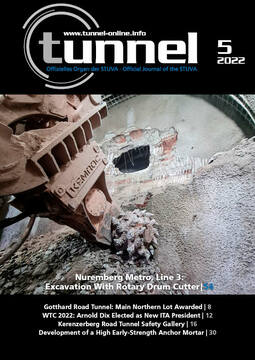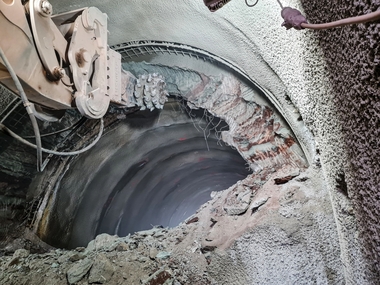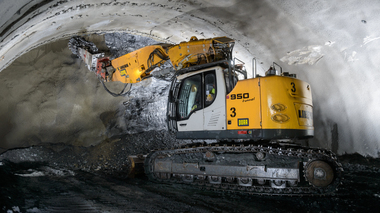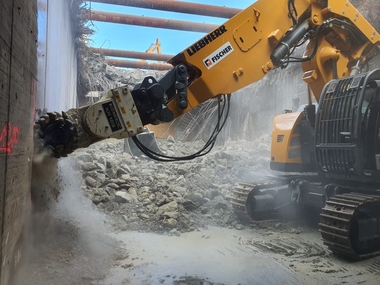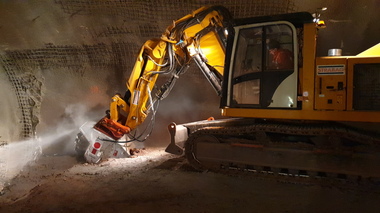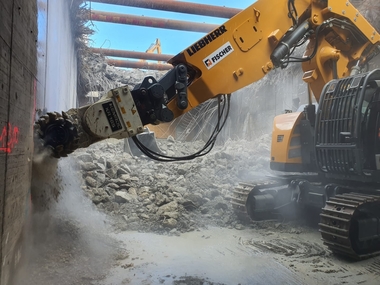Metro Tunnel in Nuremberg Excavated With Cutter
A Kemroc KR 165 rotary drum cutter in combination with a heavy special Liebherr R 960 tunnel excavator became one of the key machines in Nuremberg for driving metro tunnels. Alternating with a classic roadheader, the system ensured rapid progress on several construction sections. According to experts, this solution can also be used for other similar tunnel construction projects.
On 23 March 2022, the breakthrough on the final conventionally excavated tunnel section for the extension of underground line 3 in Nuremberg was completed exactly on schedule. Among other things, a special Liebherr tunnel excavator with a Kemroc KR 165 rotary drum cutter was used for driving.
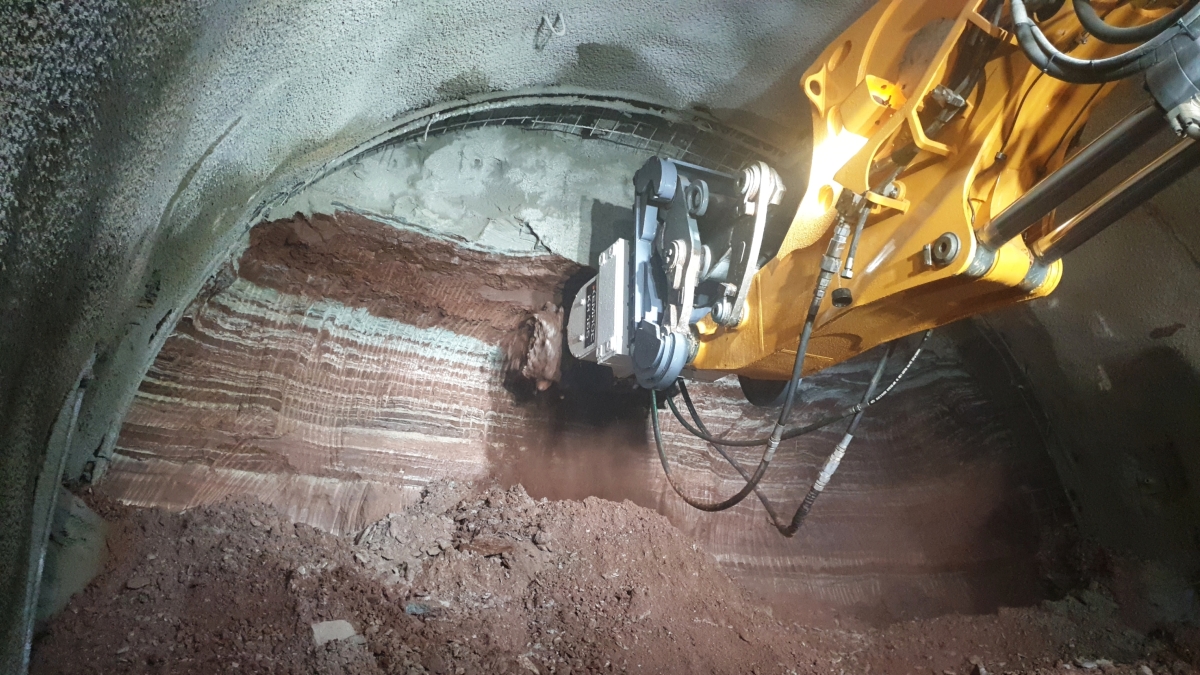 The Kemroc KR 165 rotary drum cutter in action at the working face. The excavator-cutter combination proved to be a powerful excavation system during tunnel construction for the U3 in Nuremberg
The Kemroc KR 165 rotary drum cutter in action at the working face. The excavator-cutter combination proved to be a powerful excavation system during tunnel construction for the U3 in Nuremberg
Credit/Quelle: Kemroc
Expansion of the Nuremberg Metro
The Nuremberg metro has been in use for fifty years. Its track network has been expanded gradually over the years. Since January 2020, the third and most recent U3 line has been extended to the west. By 2023, a new, 2 km long section will connect the districts of Kleinreuth and Gebersdorf above and below ground and connect to the existing line network. The contract for this construction section was awarded to the consortium “U-Bahn Nürnberg U3 Südwest BA 2.2”, shared equally by Hochtief Infrastructure (technical lead) and Max Bögl (commercial lead). The most important structures bult by the consortium include two stations, two tunnels in cut-and-cover construction, a turning facility and two conventially excavated tunnels – a single-tube (double-track), 356 m long tunnel with a cross-section of 75 m² and a twin-tube (single-track), 585 m long tunnel with a cross-section of 35 m² per tube.
The twin-tube tunnel passes under the Main-Danube Canal, the single-tube tunnel runs under a railway line. The conventional tunnelling method was chosen for its excavation. Specifically, it was planned to carry out the work steps of loosening and cutting with a comparatively powerful roadheader. In addition, a special Liebherr R 960 Tunnel excavator with a Kemroc KR 165 rotary drum cutter was used as a backup during occasional maintenance and repair work on the roadheader. This combination achieved very good performance values.
Rotary Drum Cutter KR 165
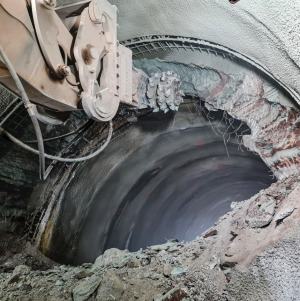 On 23 March 2022, the breakthrough took place on the last conventionally excavated tunnel section
On 23 March 2022, the breakthrough took place on the last conventionally excavated tunnel section
Credit/Quelle: Kemroc
Since 2021, the manufacturer Kemroc has also been producing classic rotary drum or double head cutters in addition to its convertible or standard chain cutters. The KR series models are the strongest on the market and are available for carriers from 1 to 125 tonnes. Due to their robust design, they are suitable attachments for low-vibration and low-noise demolition work on reinforced concrete as well as for carriers with short booms in confined locations – especially in tunnel construction. In terms of weight and performance, the KR 165 (160 kW) for excavators with an operating weight of 35 to 55 t is in the middle range of Kemroc’s rotary drum cutters. Such a KR-165 cutter was also used in Nuremberg.
Excavator-Cutter Combination as the Main Excavation Unit
After its initial use as a backup device, it was later used in alternation with the roadheader. “Of course, this mining machine remained the main excavation tool,” says site manager Ruben Mohrs, responsible for driving and inner lining on this project. “It is larger and can exert more pressure on the rock at the face. However, the combination of tunnel excavator and attachment cutter proved to be extremely flexible in the overall working procedures. For logistical reasons, the excavator-cutter combination was even used as the main excavation unit. It had particular advantages in confined spaces due to its compact dimensions. Another advantageous feature of the excavator-cutter combination was that, in addition to the main heading, cross-passages could also be excavated with great flexibility.”
On the project in Nuremberg, the tunnellers and machines had to deal with alternating sequences of mudstone and sandstone with sprinkles of clay and boulders – from a geological point of view, this was not a particular challenge for standard excavation equipment. Hydraulic excavators with mounted cutters have also been a tried-and-tested tunnelling method before, as Ralph Scheithauer, MTA manager at Hochtief, notes: “The specific geological conditions will always be a prerequisite for the use of the combination of tunnel excavator and attachment cutter. But when these conditions are met, this tunnel excavator offers a new dimension in advance performance.”
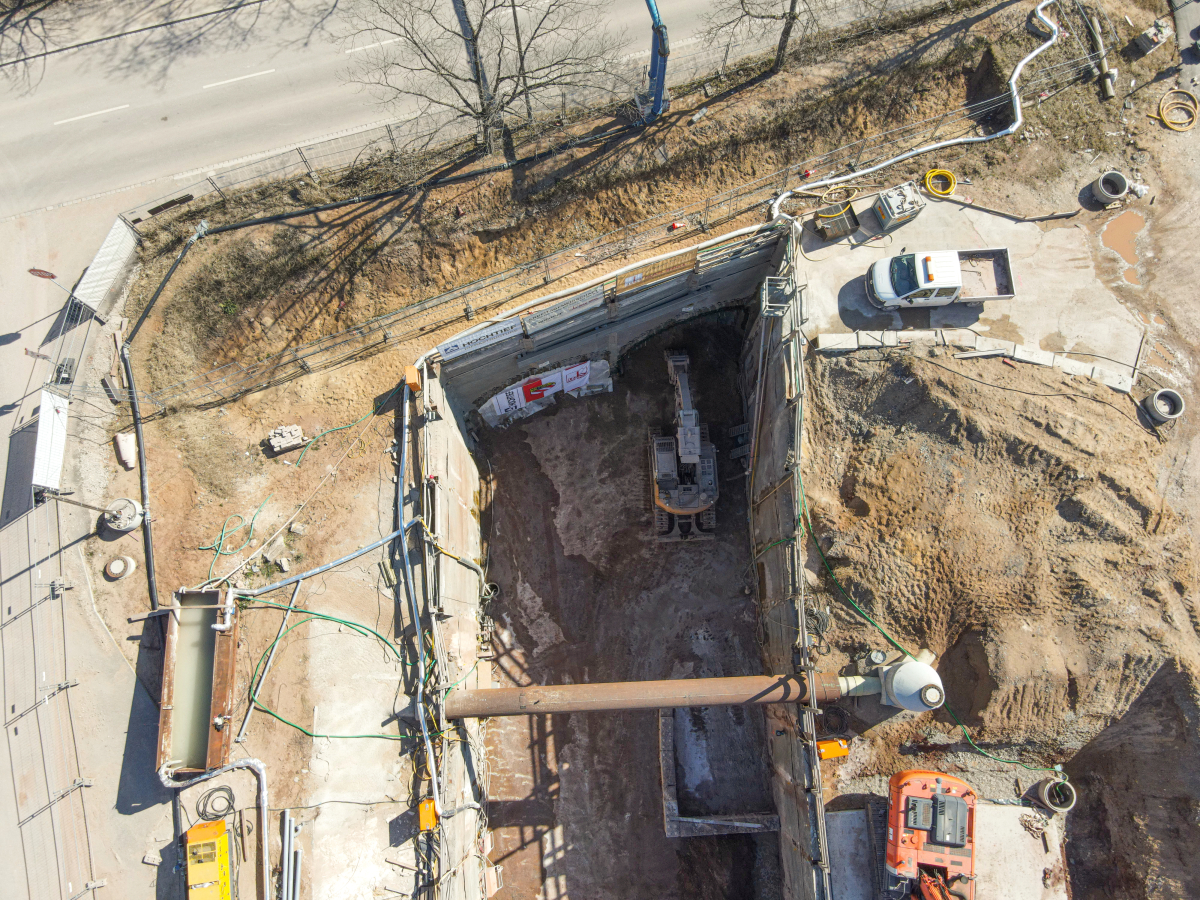 The operating environment of a tunnel excavator is typically confined. Such conditions also applied for the Liebherr excavator
The operating environment of a tunnel excavator is typically confined. Such conditions also applied for the Liebherr excavator
Credit/Quelle: Kemroc
Strong but Compact Tunnel Excavator
Ralph Scheithauer participated in a project team of tunnel construction managers and technicians from Liebherr’s Colmar factory during the two-year development of the special Liebherr R 960 Tunnel excavator. The aim was to develop a tunnel excavator that could still loosen material in a mixed geology through increased breakout force in situations where blasting would normally be necessary. A machine suitable for this purpose should be heavier and stronger, but not larger than the standard tunnel excavators on the market. Rather, it should be as compact as possible. According to Scheithauer, this has been achieved with the special 50-ton Liebherr R 960 Tunnel.
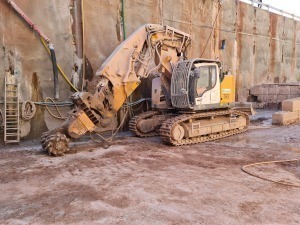 The Liebherr R 960 Tunnel has a powerful and compact appearance. With an operating weight of around 50 tonnes, it is around 6 tonnes heavier than the comparative model, the R 944 Tunnel
The Liebherr R 960 Tunnel has a powerful and compact appearance. With an operating weight of around 50 tonnes, it is around 6 tonnes heavier than the comparative model, the R 944 Tunnel
Credit/Quelle: Kemroc
“The tunnel excavators currently on the market,” he explains, “are in the performance class up to 44 tonnes. Loosening a light blasting geology or a mixed-face geology, as in our tunnel construction project in Nuremberg, is either not possible with these machines or only to a limited extent. In contrast, we used the combination of tunnel excavator and attachment cutter as a fully-fledged independent tunnelling machine.”
With an operating weight of around 50 t, the Liebherr R 960 Tunnel is about 6 t heavier than the comparative model R 944 Tunnel. It has 210 kW engine power (around 20 kW more), a hydraulic output of 2 x 317 l/min + 1 x 60 l/min (2 x 72 l/min more) and a ripping and breakout force of 275 and 346 kN (115 % and 100 % respectively).

